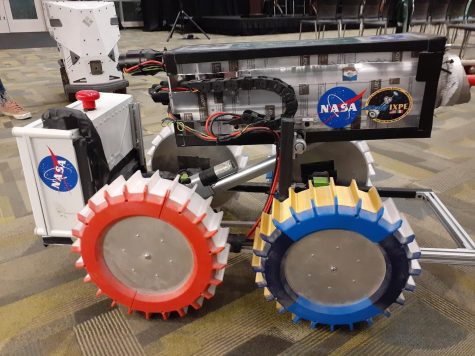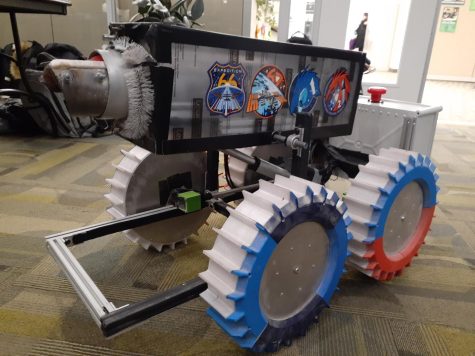Engineering Students Touched the Stars at NASA Competition
The Engineering and Technology club designed a lunar rover and won top awards with it in the NASA Robotics competition, an accomplishment they highlighted at the recent STEM Club event.
December 5, 2022
In the NASA Kennedy Space Center, 10 students from COD’s Engineering and Technology Club tested out a lunar rover that can mine into the moon’s surface. They built it themselves from scratch and won top awards against 70 other colleges in the NASA Lunabotics Robotics Mining Competition.
“The cool thing about this competition is that it was a senior capstone design project, so most of the teams we competed against were actual engineers,” described mechanical engineering student Zachary Egert. “They’ve already graduated and have jobs while majority of us were freshmen.”
At the competition this past summer, he was the driver of the lunar rover, which the judges highly praised for having the best mobility and drivetrain. The distinctive wheels with their outward, continuous track pattern were a smart design move. Other engineering students observed the design of the robot, which was on display at the STEM Club event on Dec. 1.

Egert is also co-president of the Engineering and Technology Club (ETC), which is composed of students from computer science, physics, mechanical and electrical engineering majors. Their combined skill led to the ETC team scoring 12th overall and third in the Autonomous driving category in the NASA Lunabotics competition.
ETC was one of many student-led organizations that came together on STEM Club Night to celebrate their accomplishments, recruit students to their clubs and network with each other. In clubs like Biotech, Math, Physics, and the Society of Women Engineers, students have plenty of opportunities to work on STEM-related projects.
Egert and other ETC members further described their experience in the competition and what it was like to build the lunar rover.
“It’s meant to simulate that you’re on Earth, and you’re controlling the robot when it’s on the moon, like from a station,” Egert described.
The immersive setup simulated a realistic moon environment, with rocks, craters and space dust. While the rover is sent out to mine gravel deposits, the students direct it from a remote control center.
“You’re in a completely separate room where you can’t see anything. You have access to one camera [showing the robot],” Egert said. “Whenever you put in an input for the control, there’s a time delay of about three seconds, like you’re actually sending the signal from Earth to the moon.”
Maxwell Harris is another engineering student who is co-president of ETC, as well as the leader of COD’s Math Club, which recently won the AMATYC Student Math League competition. He brought these skills and his structural engineering studies to the Lunabotics team.
“There were around 10 or 12 students in our Lunabotics team, dedicated people,” he described. “We built it from the ground up. We had an entirely new model. We decided we wanted to make something light-weight and modular.”

Though the students excelled with building it, it was very challenging at first. Harris described one of the early obstacles they faced was inexperience.
“Essentially it was all of our first times on a robotics team. Zach was able to give us a lot of helpful insight, but for the most part we were inexperienced,” Harris said. “None of us had done a competition like this before.”
Egert was the only student who had been on a robotics team all throughout high school.
“Last year because of COVID, we didn’t have any prior members, so we started really late,” Egert said. “We were able to build this in one semester, even though it’s supposed to take an entire year to build; so think about what we can do in one year.”
“We’re hoping to get first place this year,” Harris enthusiastically stated. “We’ve made a lot of modifications and idea changes to our robot. If we win first place, you can quote me and Zach, we called it,”
One design change they hope to implement is full autonomy for the robot, so that all movement is programmed at the press of one button. The STEM students bring all of their own skill and creativity, while the tools for their projects come from COD. Members of the club often take manufacturing classes that affords them full access to the TEC’s machine shop.
“At the beginning of the class, the professor teaches you about safety and how to use the machines,” Egert explained. “After that point, the officers of ETC are the ones who create the curriculum for the class for the rest of the semester. We base the curriculum on NASA’s systems engineering guidebook.”
In addition to this, the class writes research papers for NASA every year. This year, they’re excited to be writing two papers.
The ETC members also expressed a lot of hope for their build in next year’s Lunabotics competition, which will be conducted virtually. Before then, there’s another new collegiate competition they’re working on – the University of Illinois at Urbana-Champaign’s Combat Robotics competition.
“That’s our prototype. We’re bringing two more to fight in that competition,” Egert pointed to their BattleBot displayed at the STEM Night event.
The BattleBot prototype is a flat, square-shaped robot on wheels. Its attack features are horizontal bars extending from the front, like batter rams. It’s radio-controlled, not programmed with code like the lunar rover that ETC also designed.
“We put them in a fully closed arena. The robots fight and whoever survives, wins. If we all do really good, we might end up fighting each other’s [robots] in the last round,” Egert concluded excitedly. “It’s pretty cool; it’s something we’ve never done.”
The ETC club is ambitious as they look forward to new projects like this. Their creative design plans have propelled them to top awards in the past, and they hope to continue doing so in the future. To join the Engineering and Technology Club, students can use the ChapLife portal and join the club’s Discord group to directly connect with their peers.




















